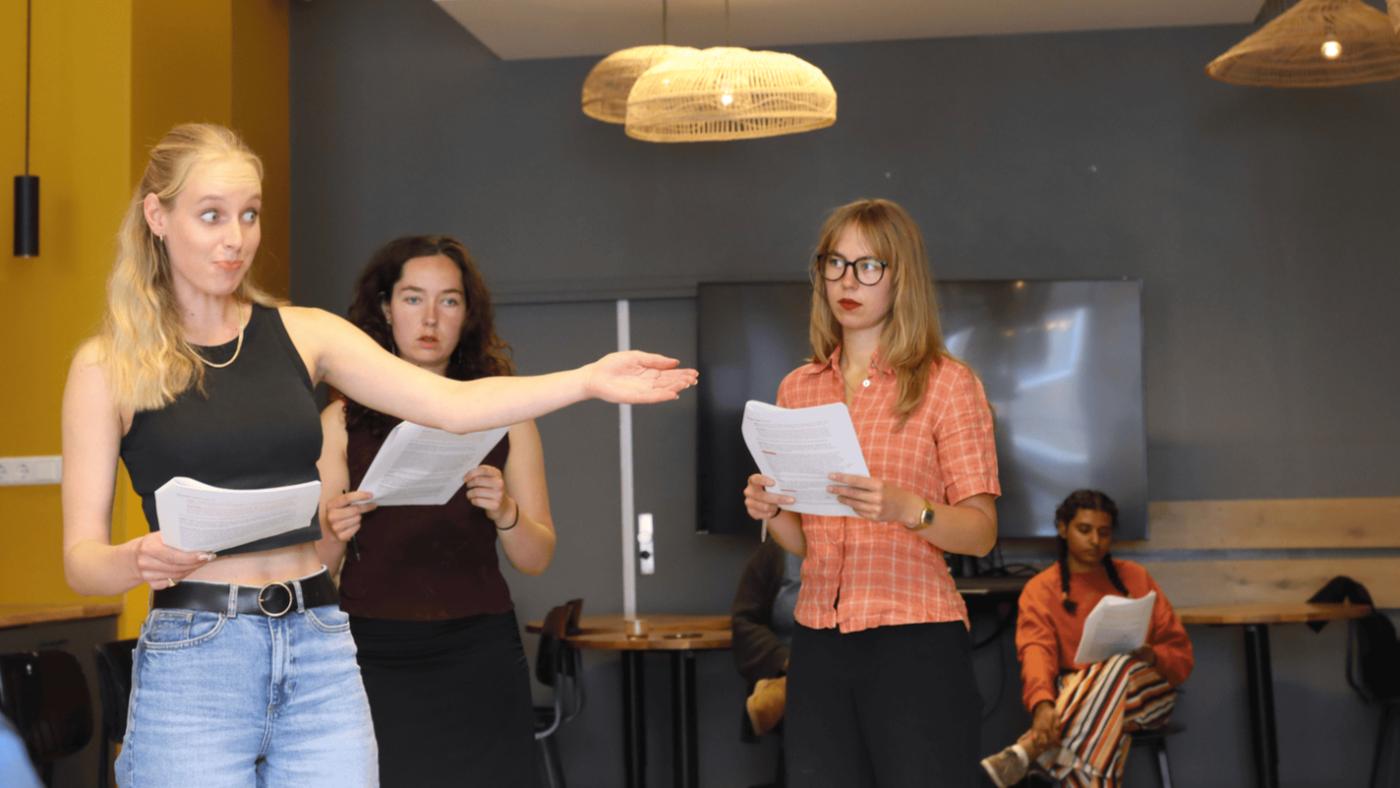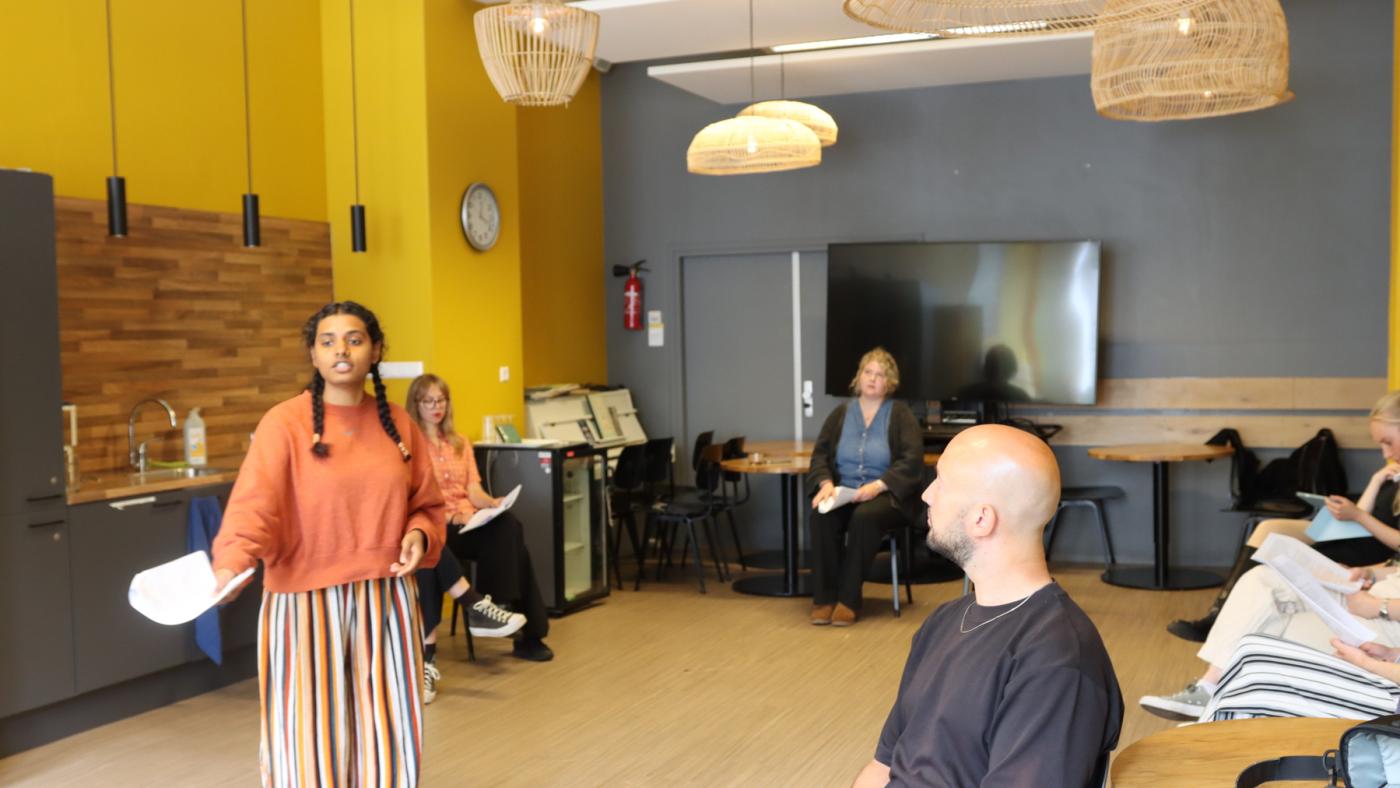Exploring ecocide in law and art
The environment gets a place in the courtroom in play with UU students

As we enter the break room at Muntstraat 2A where the actors are rehearsing, we see them going over the court case that is central to the play. The mock trial centres on a fictional Dutch company accused of ecocide because of its involvement in nickel mining in Indonesia. The prosecution is positioned on one side of the stage and the defence on the other. In the middle, we see the person on trial: the CEO of the fictional company Smit Refineries N.V. The two judges in the back mediate the arguments as the intricacies of the case unravel. Through their passionate performances, the unassuming room turns into a serious and lively court.
How to conceptualise ecocide?
The play is set in an imagined near future where Dutch law has recognised ecocide as an offence. Ecocide stands for actions that are committed with the knowledge that the act could lead to significant damage to the environment. This definition was proposed by former politician Lammert van Raan (Partij voor de Dieren) for the Dutch criminal code as an attempt to criminalise ecocide.
Law student Lorena Melisa Uysal says: “If this article is now part of the criminal code, what will it look like in a real trial? What are the things we are unsure of about the legal aspect? What would it entail for everyone? That's what we're trying to show. The best way we could do it was through this experiment, through this theatrical display of what it would look like.”
The play was developed as part of UU’s “Conceptualising Ecocide” project, funded in part by the strategic theme Pathways to Sustainability. Eight students from the Faculty of Law, Economics and Governance wrote the legal materials for the play, which were then dramatised by Reinier Noordzij, the scriptwriter and director. Two professional actors also joined the project. In addition, the play has two societal partners that provided their expertise, namely the International Union for Conservation of Nature (IUCN) and EcoJustice (formerly known as StopEcocideNL). The case scenario that the students wrote is based on actual materials that the organisations have worked on.
Thanks to the focus on an invasive industry such as nickel mining, the play explores the larger consequences of ecocide, like the endangerment of local ecosystems, deforestation, impact on Indigenous people, and threat to certain species, including the Maleo bird.

What are the limits of a courtroom?
The court case we saw in the rehearsal is not the only thing spectators will see in the performance. The play combines this mock trial with other dimensions of ecocide. Other sections explore colonial and social themes, as well as multimedia elements.
Flora Lehmann, a research assistant for the project, says that the play examines not only “how ecocide would play out in a Dutch criminal court, but also puts the whole court on trial, asking what the limits of a courtroom are.”
“We cannot bring a physical ecosystem or the Maleo bird into the courtroom and let them speak for themselves without any kind of anthropocentric frame around the ecosystem which is being defended.” That's why the mock trial and legal material are only part of the play.
“The script is driven by the ‘red line’ of the legal proceedings, but will also be broken up by different ‘windows’, or a sort of collage style,” explains Lehmann. These windows will provide insight into the colonial and societal dynamics created by ecocide law, offering glimpses into dramatic interactions.
The colonial tensions created by a Dutch company mining in Indonesia are explored thoroughly. For example, in one scene, the two professional actors take on the roles of two Dutch colonisers – a general and a soldier – and recreate the orders to raze a village in the Indonesian Banda islands. The scene is largely based on parts of Amitav Ghosh’s The Nutmeg’s Curse. In another scene, the same two actors play a Dutch couple drinking wine at home and have humorous arguments over their lack of contribution to sustainable living.
Other non-courtroom elements are meant to communicate “the environmental degradation at play and the limits of the courtroom for representing the voices of the more-than-human.” To represent these elements, the play is collaborating with the artist collective Pollif Projects, which has designed the soundscape and visual art for the play. Mirthe Dokter, from Pollif Projects, brings the Maleo bird to life through visuals and sounds as the court proceeds. This is intended to inform the audience about the bird and its relation to the indigenous land and community.

The audience is the jury
The audience will be handed a leaflet about the context of the play, though it requires no prior academic knowledge to be enjoyed. The law students say that they put a lot of effort into making the specific legal aspects accessible. “It draws on the term ecocide as something that people might have prior knowledge of,” says Lehrmann. The students know that the term ecocide connotes “genocide,” and thus, carries the cultural background and heaviness surrounding it.
“We address the audience as our jury,” says Noordzij, the director. Tina Venema, a social psychologist from the Copernicus Institute, provides the audience with a booklet in which they are expected to vote on the verdict of the trial and answer a survey that aims to “find out the effect such a theatrical performance has on people’s opinions on the matter.”
One week after the play, a more academic discussion will ensue to contribute to the exploration of the term ecocide. A public conversation about the verdict and the preliminary findings of the survey will be held, followed by a short roundtable with members of the Conceptualising Ecocide project and other community stakeholders. By including psychological, social and academic approaches, the team hopes to convey multiple perspectives on the issue.
“Ecocide and the environment have value that's far beyond the law,” says Luna Frank, another law student. The organisers chose to do a theatrical performance to bring law and art together. They believe the courtroom always includes performative aspects. “Theatre allows us to play with the expectations of the audience,” says Lehmann. The live setting engages the audience, eliciting an emotional response from them. “The spectators are going to have some level of sway in how the proposal of recognising ecocide in the Dutch law will go forward, if it is even considered,” explains Melisa.
The performance will take place on June 18 and June 19 at ZIMIHC theatre Stefanus at 8.00 pm. The general entrance fee is 15 euros, but students pay 10 euros. The panel discussion will happen on June 26 at 6:00 pm at the University Library (City Centre, Room 0.21).